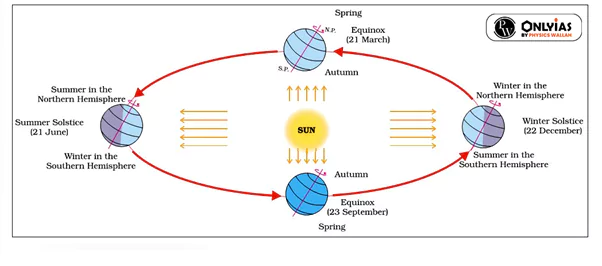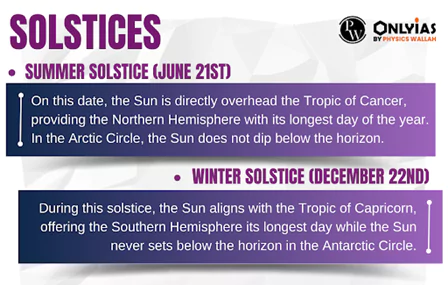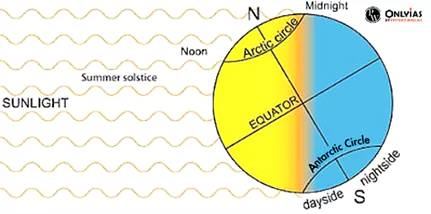Introduction: Science of the Revolution of Earth
The revolution of earth is the orbital motion of our planet as it travels around the Sun in an elliptical path. This continuous journey takes approximately 365.25 days to complete, defining the length of a year. The revolution of earth is the fundamental reason for the changing seasons, as it results in variations in the angle and intensity of sunlight reaching different parts of the globe. This celestial phenomenon is central to our understanding of time, climate, and the annual cycles of life on Earth.
Earth’s Revolution: Unlocking the Mysteries of the Revolution of Earth
The revolution of earth refers to its orbital movement around the Sun. This celestial motion is fundamental to our planet’s yearly cycle and is responsible for the changing seasons.
- Orbital Path: Earth follows an elliptical orbit around the Sun.
- This orbit is not a perfect circle but an elongated shape with the Sun at one of the foci.
- Duration of Revolution: Earth completes one full revolution of earth around the Sun in approximately 365.25 days.
- This period defines a year.
- Eccentricity and Perihelion/Aphelion: Due to Earth’s slightly elliptical orbit, it is closest to the Sun (perihelion) around January 3rd and farthest from the Sun (aphelion) around July 4th.
- Effect on Seasons: The revolution of earth, combined with its axial tilt, leads to the changing of seasons.
- As Earth orbits the Sun, different parts of the planet receive varying amounts of sunlight, resulting in seasonal variations in temperature and weather.
- Axial Tilt and Seasons: Earth’s axis is tilted at an angle of approximately 23.5 degrees relative to its orbit.
- This tilt remains constant throughout the year.
- As revolution of earth around the Sun, different hemispheres receive more direct sunlight, causing summer and winter.
- Equinoxes and Solstices: Equinoxes occur around March 20th and September 22nd when day and night are approximately equal in length worldwide.
- Solstices occur around June 21st and December 21st, marking the longest and shortest days of the year.

- Kepler’s Laws: The revolution of earth, along with the movements of other planets, follows Kepler’s laws of planetary motion.
- These laws describe the mathematical relationships governing celestial orbits.
- These laws describe the mathematical relationships governing celestial orbits.

Equinox: Balancing Light and Dark of the Revolution of Earth
Equinox refers to the astronomical event when the Earth’s axial tilt is such that neither of the poles is tilted toward or away from the Sun, resulting in nearly equal durations of daylight and darkness.
- Equinox Dates: Equinox events occur twice a year: around March 21st and September 23rd, marking the onset of spring and autumn, respectively.
- Equal Day and Night: During an equinox, the entire Earth experiences approximately 12 hours of daylight and 12 hours of nighttime, creating a harmonious balance between light and dark.
- Seasonal Significance: Equinoxes serve as crucial astronomical indicators, marking the change of seasons and providing valuable insights into Earth’s axial tilt and orbit around the Sun.
Exploring the Phenomenon of the Revolution of Earth
Why Endless Daylight Beyond the Arctic Circle in Summer?
Regions beyond the Arctic Circle receive sunlight all day long in summer due to a phenomenon known as the Midnight Sun. This occurrence is primarily a result of the Earth’s axial tilt and its orbital relationship with the Sun.

- Earth’s Axial Tilt: Earth’s axis is tilted at an angle of approximately 23.5 degrees relative to its orbit around the Sun.
- Summer Solstice: During the summer solstice, which occurs around June 21st in the Northern Hemisphere, the North Pole is tilted towards the Sun.
- This means that the North Pole receives nearly 24 hours of daylight on this day.
- Arctic Circle: The Arctic Circle is an imaginary line located at approximately 66.5 degrees North latitude.
- This line marks the northernmost point at which the Midnight Sun occurs.
- South of this line, there are times of the day when the Sun sets, but north of it, the Sun remains above the horizon throughout the entire day.
- Polar Day: Regions beyond the Arctic Circle, such as parts of Alaska, Canada, Scandinavia, and Siberia, experience what is known as the Polar Day during this time.
- It’s a period of continuous daylight, with no discernible sunset, lasting for several weeks.
- Tilted Sun’s Path: Because of the Earth’s axial tilt, the Sun’s path across the sky in the Arctic regions during the summer solstice is highly inclined.
- It never dips below the horizon, resulting in round-the-clock sunlight.
- Reversal in Winter: Conversely, during the winter solstice (around December 21st), the North Pole is tilted away from the Sun.
- This results in the opposite phenomenon, known as the Polar Night, when regions beyond the Arctic Circle experience continuous darkness for an extended period.
The same phenomenon occurs in the Southern Hemisphere, but with the roles reversed. The Antarctic Circle experiences the Midnight Sun during the austral summer, and regions beyond it receive 24-hour daylight.
| Previous Year Questions
Q.1) In the northern hemisphere, the longest day of the year normally occurs in the: (2021) (a) First half of the month of June (b) Second half of the month of June (c) First half of the month of July (d) Second half of the month of July Ans: b Q. 2) Variations in the length of daytime and night time from season to season are due to: (2013) (a) The earth’s rotation on its axis (b) The revolution of earth around the sun in an elliptical manner (c) Latitudinal position of the place (d) Revolution of earth on a tilted axis Ans: a Q.3) On 21st June, the Sun (2019)
Ans: a |































